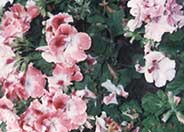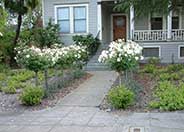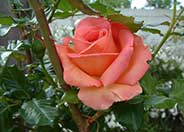
Common name:Paperbark Tree, Cajeput Tree
Botanical name:Melaleuca quinquenervia
This evergreen tree will grow 20'-40' tall and 15'-25' wide. It has distinct brownish white spongy bark that peels off in sheets. It produces yellowish white flowers that bloom in spring and fall. It works well as a street tree or in lawns.

Common name:Martha Washington Geranium
Botanical name:Pelargonium X domesticum
Pelargonium X domesticum is a shrubby perennial. It is erect or somewhat spreading to 3'. Leaves are heart-shaped to kidney-shaped, dark green, 2"-4" wide, with crinkled margins, and unequal sharp teeth. Large, showy flowers in clusters of white and many shades of pink, red, lavender, and purple with brilliant blotches and markings of darker colors are seen intermittently throughout the year.

Common name:Tree Roses
Botanical name:Rosa Tree varieties
Tree roses are actually shrubs that have been grafted or grown in a way that looks like a tree, ie with a trunk. Tree roses can be floribundas, hybrid teas, or grandifloras. They are typically used as specimen plants. Make sure the plant is tied to a stake in case of strong winds.

Common name:Garden or Common Sage
Botanical name:Salvia officinalis
This shrubby perennial will grow 1'-3' tall and 1'-2.5' wide. It has gray green leaves that are white and hairy underneath and clusters of bluish purple flowers that bloom in late spring and summer.

Common name:Hybrid Tea Rose (selections)
Botanical name:Rosa Hybrid Tea varieties
These shrubs and vines are the most loved in the Western USA and are very resilient. They come in a wide variety of sizes and colors and are easy to maintain with proper care. They can be used in a water-conserving garden with careful attention to irrigation practices.

Common name:Calendula, Pot Marigold
Botanical name:Calendula officinalis
This wonderful flower will grow about 1'-3' tall and has amazing dark green leaves with bright golden-yellow-orange flowers that bloom in winter, spring, and summer. It is an edible flower in organic gardens.
Dealing With Drought
More than half of the water used at your home is for outside purposes. Studies show that on average, half of the water used outdoors is wasted. The leading cause of waste is incorrectly set and poorly managed irrigation controllers. The second biggest cause of wastage is broken irrigation equipment that goes undetected. There are a few basic things you can do to make a big difference in your water use.
Click in the green box for more information
| Designer: | Potpourri of Colors |
Photographer: GardenSoft |
Soils and Compost:
Incorporate compost 6" into your soil to retain water, reduce compaction, feed earthworms, and provide valuable nutrients to your plants.
Water Saving Tip:
Integrated Pest Management:
Remove irrigation water and fertilizer from areas where you don't want weeds to grow.

